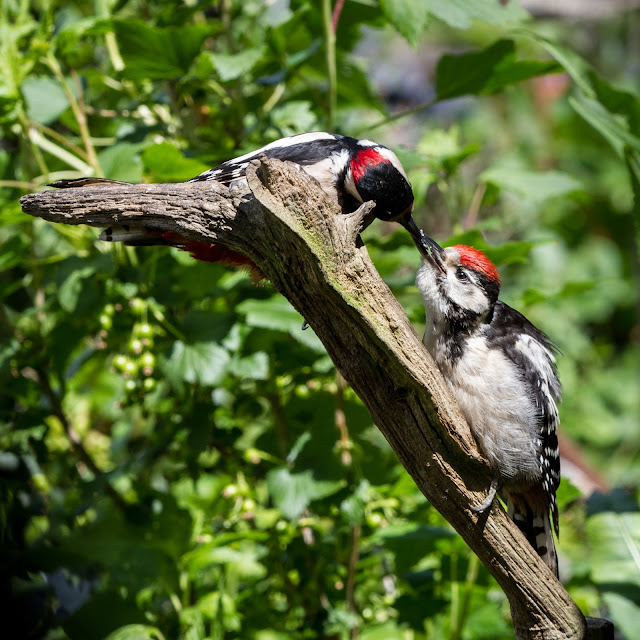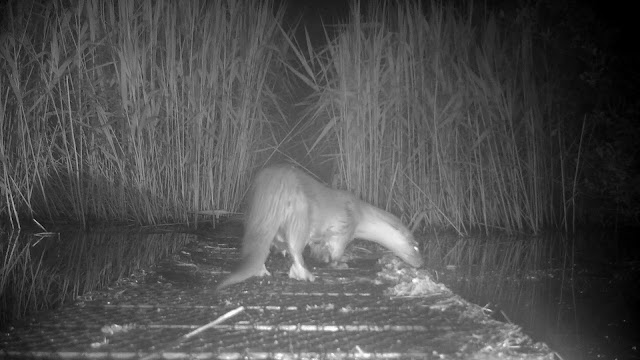My Blog List
Sunday 30 June 2019
Cubs on alert
So I don't have to spend all my time watching the cubs I set a trail camera to keep an eye on them. It recorded dozens of video clips, most of which were pretty dull. The quality is best in twilight, when the camera has switched to infrared but there is still a fair bit of natural light, although it does make the eyes look a bit spooky. Here is one brief extract.
Saturday 29 June 2019
A walk round the pond - Week 26
The rain in recent weeks has been good for nature generally but hasn't been great for insects. Fine weather over the past three days has encouraged much more activity. A new species this week was the emerald damselfly.
Another new finding was a single teneral female common darter
I also saw a single immature male broad-bodied chaser. I have still never seen a mature male here.
Several male emperors were on patrol but they were too busy to stop for a photo. The only one I saw at rest was right across the far side.
I also saw one female ovipositing, a bit too far away for my lens. I may be tempted to take the big lens next week.
There were four-spotted chasers a-plenty, enjoying the sunshine.
There were a lot more blue-tailed damselflies this week.
Large red damselflies were still around.
There were dozens of azure damselflies (this is a female)
and common blue damselflies.
The sunshine brought out lots of butterflies. There were still plenty of painted ladies, common blues and large skippers. New this week were meadow browns
and ringlets.
Some cinnabar moths now look a bit faded
but the five-spot burnets are fresh
Here's moth I don't think I have seen before. I had to look it up - it is a latticed heath (Chiasmia clathrata).
An insect I haven't noticed here before is a red and black froghopper, also known as a black and red froghopper (Cercopis vulnerata).
I definitely haven't seen this beauty before. It is a golden-bloomed grey longhorn beetle (Agapanthia villosoviridescens). It is not rare although (until now) it has not been recorded on iRecord in Northumberland.
I found a pure white orchid. Having consulted the Natural History Museum's Orchid Identification Guide, my best guess is that it is white form of the common spotted orchid (Dactylorhiza fuchsii).
Another new finding was a single teneral female common darter
I also saw a single immature male broad-bodied chaser. I have still never seen a mature male here.
Several male emperors were on patrol but they were too busy to stop for a photo. The only one I saw at rest was right across the far side.
I also saw one female ovipositing, a bit too far away for my lens. I may be tempted to take the big lens next week.
There were four-spotted chasers a-plenty, enjoying the sunshine.
There were a lot more blue-tailed damselflies this week.
Large red damselflies were still around.
There were dozens of azure damselflies (this is a female)
and common blue damselflies.
The sunshine brought out lots of butterflies. There were still plenty of painted ladies, common blues and large skippers. New this week were meadow browns
and ringlets.
Some cinnabar moths now look a bit faded
but the five-spot burnets are fresh
Here's moth I don't think I have seen before. I had to look it up - it is a latticed heath (Chiasmia clathrata).
An insect I haven't noticed here before is a red and black froghopper, also known as a black and red froghopper (Cercopis vulnerata).
I definitely haven't seen this beauty before. It is a golden-bloomed grey longhorn beetle (Agapanthia villosoviridescens). It is not rare although (until now) it has not been recorded on iRecord in Northumberland.
I found a pure white orchid. Having consulted the Natural History Museum's Orchid Identification Guide, my best guess is that it is white form of the common spotted orchid (Dactylorhiza fuchsii).
Friday 28 June 2019
The new generation of woodpeckers
I think there are more woodpeckers in the garden at the moment than I can ever remember. I saw the first independent juvenile on 7th June and there are still youngsters being fed by their parents this morning. It generally takes only a couple of days before the young birds can feed themselves, once they have learnt what to eat and where the food is. One of the advantages of year-round feeding is that I get to see so many. I reckon there must be well over a dozen individuals visiting the garden, although I haven't seen more than five at one time.
In previous years I have been ready poised with the camera in early June but I have had plenty of good photos before so I haven't made much of an effort this time. I did see these two though, while I was watching tree sparrows this week so I thought you might like to see them. The feeder was only a couple of feet away so the youngster was waiting on the sparrowhawk perch while the father was grabbing the food.
In previous years I have been ready poised with the camera in early June but I have had plenty of good photos before so I haven't made much of an effort this time. I did see these two though, while I was watching tree sparrows this week so I thought you might like to see them. The feeder was only a couple of feet away so the youngster was waiting on the sparrowhawk perch while the father was grabbing the food.
Wednesday 26 June 2019
OtterCam in June
This was the fifth consecutive month of looking for otters with the trail cameras. Previously I saw otters on every camera every night. This time I set three cameras for two nights but got only one recording of an otter on one night on one camera. At least it means the otter is still around. I am puzzled that she didn't take the food which was on the boardwalk. Perhaps she has gone off sardines - they were all eaten by a magpie the next morning. I am very restricted in where I can put the cameras at present because the luxuriant vegetation limits where I can get to and get a decent view. I'll have another go next month.
Here is the video.
Here is the video.
Monday 24 June 2019
Hummingbird hawk-moth
I have occasionally stumbled across a hummingbird hawk-moth (Macroglossum stellatarum) before but always found it very difficult to get a decent photo, mostly because they move so fast and don't stick around for long. So I was very pleased to find this one in the warden's garden at Gosforth Park Nature Reserve. It was sipping nectar from red valerian (Centranthus ruber), a characteristic favourite flower. Its long proboscis is perfect for dealing with the long-tubed flowers. The wings beat 80 times a second so the shutter speed of 1/1600s was only just adequate.
Hummingbird hawk-moths overwinter farther south in Europe and visit us in the summer. Seeing one is regarded as a good omen. A large number of moths were seen crossing the Channel on D-Day 1944.
Sunday 23 June 2019
Knock knock! Who's there?
I was woken at 4am by knocking and scratching at the bedroom window. (The bedroom is on the ground floor with French windows.) I could also hear a magpie alarm call so assumed at first that it was a magpie. The noise persisted so I got up to look and there was the culprit.
I only managed a few blurry shots with the first camera I could find and I hadn't even had time to put on my glasses. I presume the cub was attracted by its reflection in the window. It is interesting that it could get into the walled garden as the only access is over a 4 foot high wall. I hope this doesn't become a habit.
I only managed a few blurry shots with the first camera I could find and I hadn't even had time to put on my glasses. I presume the cub was attracted by its reflection in the window. It is interesting that it could get into the walled garden as the only access is over a 4 foot high wall. I hope this doesn't become a habit.
Saturday 22 June 2019
A walk round the pond - Week 25
At last there are more four-spotted chasers - patrolling, chasing, and occasionally basking so I can get a photo.
I saw no emperors this week and haven't seen one since the teneral male three weeks ago. Maybe the recent unsettled weather hasn't suited them. There are plenty of blue damselflies, both azure and common blue,
large red damselflies,
and blue-tailed damselflies.
Butterflies this week included more painted ladies,
more large skippers,
more common blues.
and several speckled woods.
The site is home to several pairs of willow warblers. The odd one is still singing but there are lots of calls so I occasionally catch sight of one.
I heard another call I didn't recognise, sounding like a persistent alarm call. I eventually got a glimpse of the source - a garden warbler. You can hear the alarm call in a xeno-canto recording here.
The garden warbler was joined at one point by two willow warblers and they were all troubled by something low down in the hedge, although I couldn't see what it was. A stoat or weasel perhaps. Both birds nest close to the ground.
I saw no emperors this week and haven't seen one since the teneral male three weeks ago. Maybe the recent unsettled weather hasn't suited them. There are plenty of blue damselflies, both azure and common blue,
large red damselflies,
and blue-tailed damselflies.
Butterflies this week included more painted ladies,
more large skippers,
more common blues.
and several speckled woods.
The site is home to several pairs of willow warblers. The odd one is still singing but there are lots of calls so I occasionally catch sight of one.
I heard another call I didn't recognise, sounding like a persistent alarm call. I eventually got a glimpse of the source - a garden warbler. You can hear the alarm call in a xeno-canto recording here.
The garden warbler was joined at one point by two willow warblers and they were all troubled by something low down in the hedge, although I couldn't see what it was. A stoat or weasel perhaps. Both birds nest close to the ground.
Subscribe to:
Posts (Atom)





























































